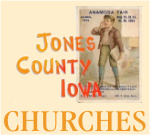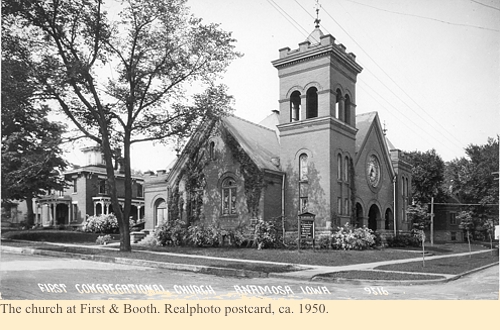
About the year 1840, Rev. Thomas Emerson commenced special Christian labor in what was known as "Big Woods," which included the whole of Fairview township and also Greenfield and Rome townships, Jones county. His labors, though brief, were attended with some success, and after his departure to Missouri, Rev. Rankin secured the names of a few persons with a view to organizing a Christian church. But finding the project beset with many difficulties he left it unaccomplished. Soon after this, about the year 1844, Rev. E. Alden, Jr., succeeded in gathering and organizing a small Congregational church in Rome, in the southern part of the county, which probably was the first Congregational church organization in the county. Discordant elements caused its dissolution early in 1846. In the spring of that year Rev. Alfred Wright visited Big Woods as a missionary, and in the September following removed to Anamosa, or to what was then known as Lexington. He labored here to impress upon the scattered Christians the need of a church organization, and on the 14th of November, 1846, Samuel Hillis and wife (parents of Newell Dwight Hillis, now of Henry Ward Beecher's church, Brooklyn), Solomon Hester and wife, Mrs. Margaret Hester, Sr., and Mrs. L. C. Wright met to consider the importance of such a step. After prayer and due deliberation a Congregational organization was agreed upon though all present were Presbyterians. Samuel Hillis was then elected deacon and on the following Sabbath the articles of faith were adopted. Rev. Wright continued his labors here until the autumn of 1853, period of about seven and a half years. His church then numbered eighty-two members, though scattered over a considerable extent of country.
In 1851 a frame house of worship was erected a little east of what was then the business portion of Anamosa. The building is now used for a residence, just in the angle of Main street, in the western part of town. This church edifice was the first erected in the county. It was neatly painted white and comfortably seated with solid oak pews. In the latter part of 1853 or early in 1854 Father Wright removed to Quasqueton, in Buchanan county, Iowa.
In 1853 the name of the church was changed from the Big Woods church to the "First Congregational Church of Anamosa." Mr. Wright was succeeded in the spring of 1854 by Rev. E. O. Bennett, who remained here but six months. Rev. H. W. Strong began his labors on January 1, 1855, and on June 1 following, Rev. S. P. LaDou commenced work here and remained one year.
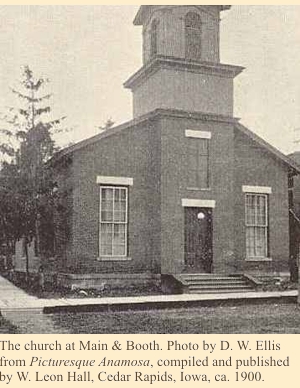 December 1, 1856, Rev. Samuel A. Benton entered upon the field and ministered to the church during a period of five years, at the close of which he left and was appointed chaplain in the Fourteenth Iowa Volunteers, under Colonel William T. Shaw. Mr. Benton served but six months when his health failed and he returned to his home. During his last year as pastor, 1861, a commodious brick house of worship was erected where the post office building now stands on the comer of Main and Booth streets.
December 1, 1856, Rev. Samuel A. Benton entered upon the field and ministered to the church during a period of five years, at the close of which he left and was appointed chaplain in the Fourteenth Iowa Volunteers, under Colonel William T. Shaw. Mr. Benton served but six months when his health failed and he returned to his home. During his last year as pastor, 1861, a commodious brick house of worship was erected where the post office building now stands on the comer of Main and Booth streets.
June 1, 1862, Rev. O. W. Merrill was called to the pastorate and continued his labors four years as stated supply. On the 20th of June, 1866, he was installed as settled pastor, and continued this relation until June, 1870, when, by his own request and by advice of council he was dismissed to act as superintendent of missions for Nebraska, a position to which he was called by the American Home Missionary society. During his ministry a debt of over seven hundred dollars was paid, the house seated at a cost of five hundred dollars, a spire erected and a bell purchased at a cost of seven hundred dollars, an organ bought and the house carpeted. From dependence on the Home Missionary society for support, the church became self-sustaining. In the eight years of Mr. Merrill's ministry eighty-five were added to the membership and the working ability of the church was more than doubled, as was also its average Sabbath congregation.
In June, 1870, Rev. Wm. Patton was chosen to fill the pulpit and remained three months. In 1871, Rev. R. M. Sawyer began his ministerial labors and remained one year.
September 1, 1872, Rev. J. B. Fiske entered on this pastorate, and after serving his people most effectively for sixteen years he resigned September 1, 1888, removing to Bonne Terre, Missouri, where he became the pastor of the Congregational church of that place.
Rev. W. W. Willard was called April 25, 1889, to fill the pulpit, to begin September 1st, it being understood that his stay would be for only a short time.
Following the death of Mrs. J. B. Fiske, at Bonne Terre, a beautiful memorial service was held in the church February 6, 1890, at which addresses were made and appropriate resolutions adopted.
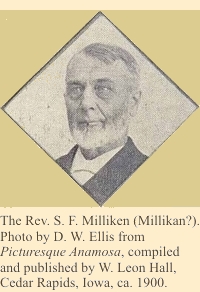 Rev. E. W. Beers followed Rev. Willard as pastor about the 1st of October, 1889, and remained one year. Rev. W. R. Stewart commenced his labors as pastor December 7, 1890, and remained about two years. Rev. S. F. Milliken entered on the pastorate May 1, 1893, and remained until March 1, 1902, and then accepted a call to Kingsley, Iowa. Dr. J. H. McLaren was called December 11, 1902, and began his work early in January following. The building of a new church was suggested soon after Dr. McLaren entered upon his pastorate. At a prayer and business meeting held May 28, 1903, the pastor stated that Mrs. E. P. Benton, of Minneapolis, a former member of this church, as was her now deceased husband, would give half the sum required for a new church, a statement received with profound gratitude by all. The pastor and Messrs. H. H. McKinney, J. S. Condit, C. S. Millard and Mrs. E. A. Osborn were appointed a committee to solicit subscriptions. September 3, 1903, a resolution was adopted authorizing the purchase from Mrs. T. R. Ercanbrack of lots 1 and 2 and the north sixty feet of lot 3, comer of First and Booth streets for five thousand dollars, and to sell the old church, the cost of the new structure not to exceed fifteen thousand dollars.
Rev. E. W. Beers followed Rev. Willard as pastor about the 1st of October, 1889, and remained one year. Rev. W. R. Stewart commenced his labors as pastor December 7, 1890, and remained about two years. Rev. S. F. Milliken entered on the pastorate May 1, 1893, and remained until March 1, 1902, and then accepted a call to Kingsley, Iowa. Dr. J. H. McLaren was called December 11, 1902, and began his work early in January following. The building of a new church was suggested soon after Dr. McLaren entered upon his pastorate. At a prayer and business meeting held May 28, 1903, the pastor stated that Mrs. E. P. Benton, of Minneapolis, a former member of this church, as was her now deceased husband, would give half the sum required for a new church, a statement received with profound gratitude by all. The pastor and Messrs. H. H. McKinney, J. S. Condit, C. S. Millard and Mrs. E. A. Osborn were appointed a committee to solicit subscriptions. September 3, 1903, a resolution was adopted authorizing the purchase from Mrs. T. R. Ercanbrack of lots 1 and 2 and the north sixty feet of lot 3, comer of First and Booth streets for five thousand dollars, and to sell the old church, the cost of the new structure not to exceed fifteen thousand dollars.
Some time after this, Mr. E. M. Condit, traveling abroad with his wife, gave assurance that he would help the enterprise, and later forwarded his check for two thousand dollars, which was another cause for gratitude and praise to God.
The building committee consisted of Dr. J. H. McLaren, J. S. Stacy, M. L. HoIlister, C. S. Millard, A. J. Byerly and T. E. Booth. Mr. Willard was made treasurer and Mr. Booth secretary.
The purchase of the Ercanbrack property was completed and Mrs. Ercanbrack generously donated two hundred and fifty dollars toward the new church. Plans were accepted from J. H. Prescott and bids followed by several builders. The award went to Anton Zwack, of Dubuque, for fourteen thousand, three hundred dollars. March 21, 1904, the trustees were authorized to sell the old church to George L. Schoonover for four thousand dollars, reserving the bell, seats, organ and other furnishings, and it was sold accordingly.
April 7, 1904, Dr. McLaren having resigned, it was voted to extend a call to Rev. A. O. Stevens, of Pontiac, Michigan, to become pastor, and later he was added to the building committee. Following the sale of the old church, and before it was turned over to Mr. Schoonover, a "last meeting" was held in the church on the 12th of April, short addresses being made by T. E. Booth, J. S. Stacy, J. H. Barnard, E. J. Wood, A. Heitchen, C. S. Millard, G. L. Yount and Rev. A. O. Stevens.
A large number of the members of the church and congregation were present and a service was enjoyed that will never be forgotten.
By courtesy of the city authorities, the congregation occupied the city hall for some months and until the new church was ready for occupancy. The corner stone was laid December 15, 1903, with appropriate ceremonies, conducted by Dr. McLaren, Others participating were Rev. W. E. Glanville, of the Baptist church. Miss Bates, assisting at the Methodist Episcopal revival meetings, sang a solo. Rev. J. Percival Hugget, of Cedar Rapids, delivered an interesting discourse, and Rev. L. L. Lockard, of the Methodist Episcopal church, and Rev. DeWitt White of the Presbyterian church extended words of greeting.
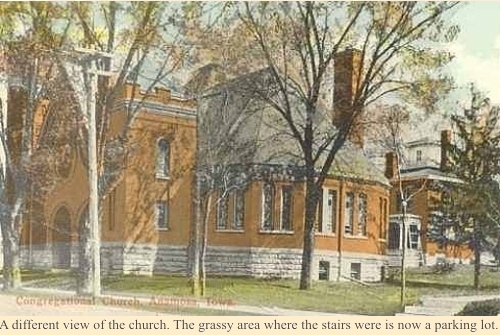
September 30, 1904, the dedication recital, at which was given the first public exhibition of a pipe organ in the history of the town, Mr. Kenneth E. Runkel, of St. Paul, Minnesota, conducting the recital, assisted by Mrs. Harry W. Sigworth, soprano, and Mr. Dwight E. Cook, tenor.
On Sunday, October 20, 1904, the dedication of the church took place, the audience room, both wings and the gallery being packed and aisles filled. The exercises were opened by an organ prelude by Mr. Runkel, followed by the Doxology and Lord's prayer, responsive reading and an original hymn written by Rev. J. N. Davidson, of Dousman, Wisconsin, formerly a member of the church. T. E. Booth, of the building committee, reported the contributions for the enterprise.
Mrs. E. P. Benton $11,500, E. M. Condit $2,000, Church Building Society $1,000, Old church property $4,000. Local subscriptions (4,869) $23,369.
There was an indebtedness of only eighty-seven dollars and that and more was quickly raised by a basket collection, Dr. T. O. Douglas, of Grinnell, making an appropriate address. Rev. A. O. Stevens, the present pastor, then in happy words introduced Dr. McLaren, who preached an eloquent dedicatory sermon, with theme, "Triumphant Zion," the sermon being published in full in the Eureka.
March 5th, 1905, Rev. Stevens resigned and on July 9th following Rev. Chas. H. Beaver, of Fairmont, Neb., preached morning and evening and on the 17th a unanimous call was extended to him to enter on this pastorate, which was accepted, and Mr. Beaver is still with us, doing a good work for the spiritual life of the church and enlarging the congregation and Sunday school.
One year ago, under the care and direction of Mr. Beaver, the entire interior of the church was beautifully decorated, and other repairs made at a total cost of about three thousand, six hundred dollars, which included an enlargement of the basement dining rooms, roof rebuilt and a new furnace in the parsonage, with other repairs and furnishings of a valuable nature.
Because of these improvements, recognition services were held October 29th, 30th and November 1st, with elaborate programs, musical and otherwise, including a men's banquet under charge of the Men's club of the church, and addresses by T. E. Booth, Richard Owen, Rev. M. A. Breed, of Monticello, Rev. Wilson Denny, of Cedar Rapids, Rev. Charles A. Moore, of Davenport, and Rev. Charles A. Beaver, the pastor. All these exercises were free and they were greeted by large and appreciative audiences.
